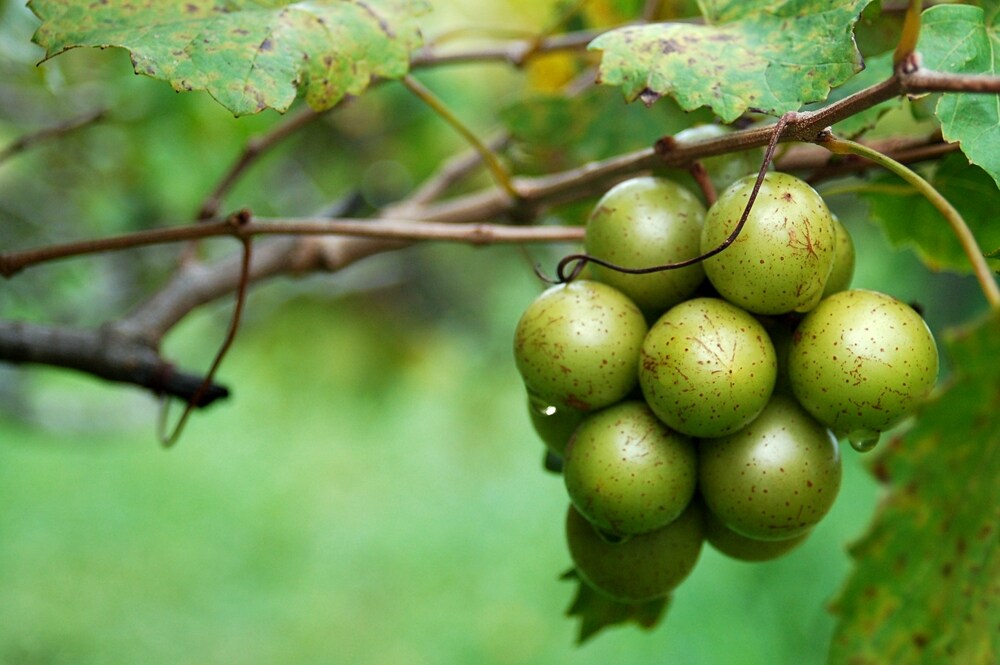 Muscadine grapes have a distinct fruity flavor and are important in winemaking. During the ripening process, chemical reactions occurring over time influence the flavor and aroma specific to this type of grape. Recently, Kambiranda, et al. analyzed ripening muscadine grapes at certain stages to identify proteins that convey flavor.
Muscadine grapes have a distinct fruity flavor and are important in winemaking. During the ripening process, chemical reactions occurring over time influence the flavor and aroma specific to this type of grape. Recently, Kambiranda, et al. analyzed ripening muscadine grapes at certain stages to identify proteins that convey flavor.
Between July and September 2013, researchers collected muscadine grape (Vitis rotundifolia cv. Carlos) samples at different developmental stages from the vineyard of the Center for Viticulture and Small Fruit Research, Florida A&M University, Tallahassee, Florida. They collected grapes at four maturity stages: green hard (CGH), green soft (CGS), bronze soft (CBS) and ripe. Additionally, they collected samples at 60, 73, 85, and 118 days, after the opening of flowers (postanthesis).
After sampling grapes, they recorded the berry diameter, berry weight, and °Brix sugar content. They also measured the titratable acidity (g/L) in a small portion (30 berries) by titrating grape juice to a pH 8.4 endpoint with 0.1 N NaOH.
In this analysis, the team collected (200 berries) from multiple clusters of the same grapevine and considered this as one biological replication. In total, they collected three biological replicates (200 berries × three different grape vines). The data obtained are the mean ± SD of three replicates. The team stored the remaining berry samples (∼130 to 150 grapes) at −80 °C for further analysis.
For the proteomic analysis, Kambiranda et al. removed seeds from the partially frozen grape samples and collected the pericarp portion of the grape. The team used a phenol-based extraction protocol to isolate proteins and then performed a trypsin digest prior to high-resolution electrospray tandem mass spectrometry on an LTQ Orbitrap Velos mass spectrometer (Thermo Scientific). They used standards of catechin, epicatechin, and four stilbenes to compare observed proteome changes. The researchers also quantified phenolic extracts on a different mass spectrometry system, which was consistent with previous studies.
The researchers identified 1,411 proteins during ripening with 522 showing differential expression according to p-value of <0.05. Of these differentially expressed proteins, 30 proteins are associated with the production of key phenolic compounds, whereas 25 are associated with the production of muscadine aroma compounds. These results are viewable at PRIDE (PXD 001959). A functional analysis revealed that the greatest number of proteins are involved in secondary metabolism (16%), carbohydrate (15%), amino acid metabolism (8%), and protein processing (6%). The researchers explain that these proteins are members of the phenylpropanoid pathway, involved in terpene synthesis, fatty acid derived volatiles and esters that affect muscadine berry flavor and aroma characteristics.
Taken together, the results by Kambiranda et al. reveal biochemical changes during ripening can help with marker-assisted breeding to further improve taste and aroma.
Reference
Kambiranda, D.J., et al. (2016 ) “In Depth Proteome Analysis of Ripening Muscadine Grape Berry cv. Carlos Reveals Proteins Associated with Flavor and Aroma Compounds.”, Proteome Research. Sep 2;15(9): (pp. 2910-23) doi: 10.1021/acs.jproteome.5b01064. Epub 2016 Aug 8.


Leave a Reply